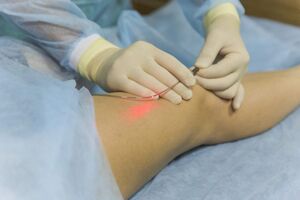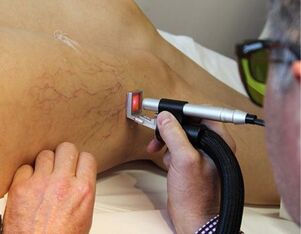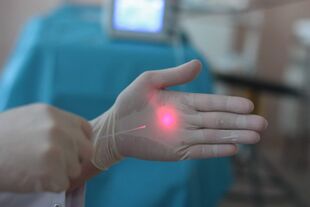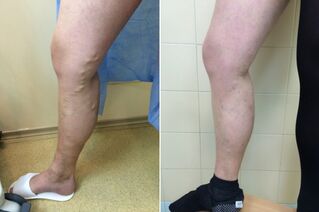A disease in which the veins enlarge, expand and lose their elasticity is called varicose veins. The result of the disease is not only a noticeable cosmetic defect, but also the formation of ulcers, which are accompanied by severe pain. Laser treatment of varicose veins of the lower extremities is one of the most modern and painless methods of getting rid of the disease.
Procedure protocol

The laser treatment of varicose veins is carried out with an ultrasonic duplex scanner. In this case, absorption of laser energy by hemoglobin from erythrocytes occurs.
As a result, they are converted into thermal energy within a few seconds, the value of which reaches 100 degrees. Boil blood plasma and its elements. This process can be compared to a kind of thermal burn of the vein walls, which causes the formation of a blood clot.
After a short time, the veins dissolve and become almost invisible. If the disease is at an advanced stage, the operation must be repeated. This cannot be done earlier than 30-40 days.
The method's popularity is due to its inherent advantages. The most important are:
- The operation is carried out on an outpatient basis. The patient only spends a few hours in the clinic.
- The procedure does not require general anesthesia. It is sufficient to only numb the area where the laser catheter is inserted into the vein. This means that the rehabilitation time is significantly shorter.
- No drug therapy is required after the operation.
- Specialists monitor the progress of the operation using ultrasound monitoring using the color Doppler. This guarantees the accuracy of the process.
- After the operation, there are no post-operative stitches, punctures or other cosmetic defects on the patient's skin surface.
- The postoperative period does not require bed rest.
- The operation is performed with a single instrument intended for endovascular procedures. This minimizes the risk of infection in the body.
The presence of these and other advantages confirms the effectiveness and efficiency of the procedure for removing varicose veins with a laser.
Indications for laser surgery
Laser treatment of varicose veins is indicated in patients diagnosed with enlargement of the large and small saphenous veins. In this case, the size of the extent of the venous opening does not exceed 1 cm, and the vessels are evenly arranged without the formation of numerous bends.
Using a laser is only effective when the disease is in its early stages of development.
For whom this method is prohibited

Laser removal of leg veins is not recommended if the disease is in the second, third, or fourth stage of development. The reason is that it is possible for the vein to enlarge again.
It should also be noted that the laser affects a small area of the vein, which can prevent damage to the surrounding tissue. When a person has a large venous lesion, using laser therapy will not produce the desired result.
When we talk about contraindications to the use of a laser, they can be broadly divided into two groups:
- Absolutely.This includes those cases in which the use of the laser is strictly prohibited:
- the patient has the possibility of developing thrombophlebitis;
- chronic blood diseases are observed;
- Vein walls show severe lesions.
In these cases, the use of a laser can cause massive blood clots.
- Relative.This group contains contraindications that must postpone the operation with a laser for some time:
- Presence of wounds or ulcers on the patient's skin surface. You need to be healed first. Otherwise, the possibility of complications in the postoperative period cannot be excluded.
- pregnancy and breastfeeding. At this point, the female body is weakened and the lower limbs are heavily stressed.
- overweight.
If a patient has contraindications from the first group, experts recommend using another method of treating varicose veins. If there are relative contraindications, they must be eliminated prior to laser therapy.
Preparation

One of the advantages of laser vein treatment is that the patient does not have to go through a long preparation period.
Preparation before the operation consists of performing a standard examination, which includes the following manipulations:
- blood and urinalysis, in which the presence of a sugar level is determined, the degree of blood clotting is determined, a blood biochemistry is carried out, the Rh factor and blood type are determined;
- tests for HIV and the presence of sexually transmitted diseases;
- fluorography;
- With the help of ultrasound, specialists precisely determine the location of the expansion on the leg veins.
- If the patient is very excited, sedatives are given.
After completing these manipulations, you can proceed with the operation yourself.
Which method should be selected?
In addition to endovascular laser coagulation, several effective methods can be used to treat varicose veins. The most popular are:
- Compression therapy.The essence of the method is the external compression of the veins, which leads to a reduction in their size. After the operation, the length of the vein may increase. Most patients will have a need for compression therapy for the rest of their lives. Leg vein laser surgery eliminates this need.
- Phlebectomy.In this case, the vein is surgically separated from the general venous system. In this case, the diseased vein will be completely removed, which will minimize the recurrence of the disease. The disadvantage of this method is the compulsory use of general anesthesia, which leads to an extension of the rehabilitation period to 3 - 4 weeks.
- Sclerotherapy.This is an invasive treatment that uses a special foam. A sclerosant is injected into the patient, which causes the vessel to stick together. The possibility of developing postoperative consequences such as tissue scars, skin surface necrosis, allergies, migraines and others is not excluded.
- High frequency obliteration of veins.Performed using radio waves. The catheter is inserted into the vein. Radio waves cause heat to build up and stick together in the vein walls. This method is contraindicated in patients with pacemakers or defibrillators.

Of all the above methods, EVLO of varicose veins is the gentlest and most effective. The final decision on the choice of a method of treating varicose veins can only be made after a thorough general examination and the recommendation of a specialized phlebologist.
Perform the operation
Removal of varicose veins with a laser is a manipulation that takes no more than 30 minutes. It is carried out in several steps:
- In accordance with the previously created map of the patient's veins, the specialist performs local anesthesia, during which the punctures are performed.
- A catheter, which is equipped with a laser at the end, is inserted into the vascular cavity.
- The catheter is gradually advanced into the groin and then withdrawn. When this happens, energy is released that seals the vein.
In order not to damage the mucous membrane of the eyes, the patient must first wear protective goggles.
How long
One of the advantages of the method of laser coagulation of vessels on the legs is that the operation itself does not take more than 30 minutes.
After this time, the patient can leave the clinic alone. The short duration of the method is due to the lack of general anesthesia, as well as surgical incisions on the surface of the skin on the patient's legs.
Post-operative recovery
Laser therapy for varicose veins includes a short postoperative period. Experts recommend the patient to adhere to the following rules for it to work correctly:
- wear compression clothing;
- Avoid heavy strain on the legs.
- walk in nature as much as possible;
- to do an ultrasound 10-14 days after surgery. This gives the specialist a picture of the condition of human veins in the places of intervention.
Within 2-3 months the patient is fully recovered and ready to lead his normal life.
Results and possible consequences
If laser vein surgery is done on time, the chances of the disease coming back are very small. The patient returns to his normal and familiar way of life after a few months.
Negative consequences after the operation to remove varicose veins on the legs are very rare. This can usually be a slight pigmentation of the skin where the puncture was performed. It can be eliminated by taking medication.
Average cost of laser treatment
It's safe to say that the cost of laser treatment for varicose veins in the legs is the only downside to the method. It depends on such factors as the degree of development of the disease, the equipment used for the operation, the individual characteristics of the patient, and other factors.
Despite the high costs, this method is considered the most effective worldwide.

























